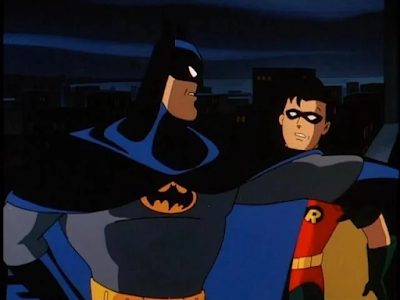Most of both parts of this story have to do with emotion. As the Darknight Detective, The Batman is frequently presented as divorced from emotion. He's the shadow of the night that implacably pursues criminals in the name of protecting Gotham City. But his image as presented often means that citizens are almost as nervous around him as criminals are. What softens that image to some is the presence of the much more human Robin, who not only cracks jokes but also wears a costume that's an absurd contrast from The Batman's deep blues and grays that keep him hidden in the shadows (except for the blazing target in the middle of his chest...) But Robin wears a costume emblematic of his circus background. The only problem is that, as presented in these two episodes, it brings him awfully close to matching the image of a clown.
The episode begins with Bruce and young Dick Grayson engaging in fencing practice. In the course of said practice, it demonstrates how enthusiastic, reckless, and emotional Dick is at his young age, which is understandable. The problem is that college-aged Dick is also just as reckless and emotional, which creates a contrast to The Batman not just in presentation, but in execution. The Batman is controlled, precise, and careful to protect both the citizens of Gotham and any activity that might threaten his identity and, thus, those around him. Robin, meanwhile, goes in guns blazing to every encounter. In this episode, it's presented as a consequence of pursuing Tony Zucco, the man who killed his parents. But it's also present in the previous episode before we even knew we'd be delving into Dick's past. It's also displayed by the younger Dick when he gets onto Zucco's trail, as well. Robin was created by Kane as a character for kids "to relate to" and imagine themselves being, working alongside The Batman. The problem is that most kids already imagine themselves being The Batman, rather than his goofy sidekick. But even if they were imagining themselves as Robin, instead of the Caped Crusader, they're now presented with an image of themselves being the most antithetical partner that The Batman could ever have. It's a really strange approach to both concept and story.
This is furthered by some of the story details and moments. At one point, we see crooks on the streets running and hiding because the Batwing is hovering over the streets. The Darknight Detective's whole approach is to be lurking around the rooftops, unseen, until he suddenly appears and terrifies them; such that they'll never know in the future if he's around the corner and, consequently, might decide to not engage in their nefarious activities. The idea that they'll have the opportunity to run and hide because they can hear the VTOL jets of the Batwing from blocks away doesn't suit the character's MO at all. This is alongside other mildly clumsy moments in the script, such as Paulie's Pool Hall, which seems like an obvious reference to a recent gangster movie of inordinate fame. Then there's Dick running into the stereotypical hooker-with-a-heart-of-gold when he's first searching for Zucco. Some of this seems like padding for a story that honestly might have been able to be told in a single episode, rather than two, and the reason for that padding is, of course, because it's Robin's origin story.
That emotional angle comes to a fairly explosive climax, as The Batman locates Tony Zucco's hideout when the latter is panicking about being pursued by him ("He's a dark angel a'death, man!") and Robin ends up reaching a moment where he could easily let Zucco fall to his death, only to be stopped by his mentor. That engenders an explosion from Robin where the most predictable line emerges: "You can't possibly know how I feel-!" when, of course, Bruce absolutely knows how he feels and Dick realizes it a moment later. This is accompanied by Bruce explaining that he tried to keep his ward out of this fight for fear that the man who took Dick's parents' lives might also take the life of what is effectively the only child that Bruce will ever have. The emotional weight attached to both of them in the course of this story does sell it better than the overall presentation, but it doubtlessly works better for actual fans of the Robin character. Next up is the greatest Joker story ever told: The Laughing Fish.




No comments:
Post a Comment
Note: Only a member of this blog may post a comment.